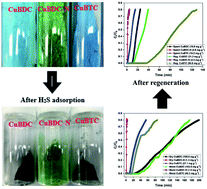Chemisorption of hydrogen sulfide over copper-based metal–organic frameworks: methanol and UV-assisted regeneration†
Abstract
Three copper-based metal–organic frameworks (MOFs) with different organic linkers were synthesized for the removal of H2S gas at room temperature. The synthesized MOFs were characterized by microscopic and spectroscopic techniques to understand their structural, functional, and optical properties. The H2S adsorption capacity of MOFs calculated by column studies followed the trend: 105.6 mg g−1 (CuBDC) > 27.1 mg g−1 (CuBTC) > 1.3 mg g−1 (CuBDC-N) in dry conditions. The adsorption capacity increased in moist conditions due to an easy dissolution and dissociation of H2S in a film of water. X-ray photoelectron spectroscopy confirmed the presence of sulfur bound to Cu-sites and sulfate ions. The spent MOFs were regenerated by the successive effect of methanol and low power UV-C radiation. The regenerated CuBTC showed an exceptionally high adsorption capacity of 95.6 mg g−1 in the second cycle, which was linked to the reactivation of Cu-sites and improved surface area and porosity. The regeneration process developed in this study is a cost-effective method to recycle chemisorbed MOFs without compromising with their structural and functional integrity.

- This article is part of the themed collection: Metal-organic frameworks and their applications


 Please wait while we load your content...
Please wait while we load your content...